Whether you’re a collector, a wearer or just an appreciator of jewelry, there is no denying that adornments made of rare stones & elements have charmed people from all cultures for thousands of years, which explains their ever increasing value. Jewelry is the means to symbolize concepts or emotions as well as a way of self expression–for example, gifting jewelry can be a way to show appreciation, love or even kinship and wearing certain types of jewelry can signify marital status or the grandness of the occasion.
It’s no wonder then why certain jewelry pieces become historical icons, with some famous examples featured below:



Learning to understand different types of jewels (also known as gems & gemstones) can be an exciting and very rewarding experience, though it demands some effort. Given how colloquially terms pertaining to gems are used more loosely than their strict definitions, it also requires precise knowledge and speech, which can take years to learn. Experts in jewelry making, manufacturing or selling have this extensive training and while we can’t offer years of knowledge in one blog post, we can provide you with a speedy guide on different types of precious stones & elements, and quick know hows on understanding why their values vary across the spectrum. Additionally, we use customer’s picks from our jewelry lines to present much of the information, which we hope embellishes your reading experience!
The Jewel: Precious & Semi-Precious Stones
The gemstone of the jewelry piece is often in the center and presented as the main focus of attention, as they are usually the most unique part of the piece. The stones are categorized into precious or semi-precious stones which gives the false impression that precious stones are more rare and thus, more valuable than their semi precious counterparts. In reality, this isn’t true – the classification is arbitrary and in some parts of the world, somewhat outdated. In the West however, this terminology is still common and the precious stones still refer to diamonds, emeralds, rubies and sapphires – these gems comprise the 4 true precious stones by definition and all other gemstones are categorized as semi-precious stones.
As a handy resource, we made the list below for the most popular precious and semi precious stones used for jewelry, along with their distinguishing characteristics and the best type of band pairing. All items are available on our website, which you can access through clicking the image.







There are many, many more semi precious stones which are made into beautiful jewelry pieces, some featured below!
Evaluating the Jewel
In general jewelry appraisers look at 4 qualities or the 4C’s (cut, clarity, color and carat) to measure the true value of a single jewelry piece –the method as it stands is the most effective for diamonds and while it is still the basis of the approach for the colored gems, a more complicated system is in place to evaluate the true color quality of the gem, with sub-categories such as hue, saturation, tone and coverage.
The aim of the practice is to see how these four qualities are balanced in a single jewel, as some have to be compromised for the sake of the other –for example, cutting a colored stone to display best color, or hue might mean less carat weight, which might be undervalued later. In fact, cutting is so important for how these qualities come together that the choices made by the cutter are even given its own name, “cutter’s tradeoff”. The cut of the gem determines the style of the jewel and sometimes the design of the entire piece, and so it’s not an overstatement to say that the cut also determines much of the value for the piece – that being said, while some cuts offer the best balance between the four qualities of the jewel, some customers have personal preferences for the shape of their jewels, which has recently become a more prominent factor in people’s selection process.
The Band: Rare elements
The precious elements are the naturally occurring elements silver [Ag] and gold [Au]. Silver is found in its lustrous white metal form, whereas gold is found as a soft metal exhibiting a yellowish color. Along similar lines as gems, the precious elements, silver & gold are very rare and valued for their purity, which is measured in carat.


Evaluating Gold & Silver Purity
Wearable gold & silver can never be 100% pure as it requires alloys for durability & shape maintenance (additives are also ways by which yellow gold is made into white & rose gold). In its purest form, gold weighs 24k, which means it contains over 99% gold – the best quality for gold is thought to be between 18k -24k.
While gold is a classic choice to pair with gems such as diamond, amethyst, emerald & blue topaz. It can also be worn on its own and is elegant as everyday jewelry.




Yellow gold is best paired with diamonds, peridot & citrine and is also often worn on its own for an understated yet elegant look.





Silver in its purest form is called sterling silver, and contains 92.5% silver which is why it’s sometimes denoted as 925 silver, Sterling silver jewelry is a popular choice to pair with diamonds, sapphires & amethyst and is an equally popular pick for everyday use on its own – durability of sterling silver and its resistance to corrosion are its most known qualities, which is why we highly recommend sterling silver for jewelry that you rare take off.






Customer Favorites
Now that you are aware what makes gems & elements “precious”, you can view the different ways they can be styled below:
Perfect for: Everyday Casual





Perfect for: Special Occasions





Perfect For: Exceptional Occasions





We hope that this was an informative beginner’s guide to precious jewels and elements. Leave your comments below!
